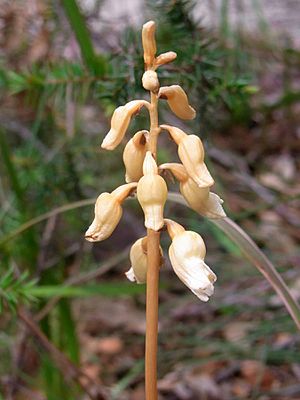Cinnamon bells facts for kids
Quick facts for kids Cinnamon bells |
|
|---|---|
 |
|
| Gastrodia sesamoides in Ku-ring-gai Chase National Park | |
| Scientific classification | |
| Genus: |
Gastrodia
|
| Species: |
sesamoides
|
The cinnamon bells orchid, also known as Gastrodia sesamoides, is a special plant found in Australia and New Zealand. In Australia, people also call it the common potato orchid. In New Zealand, it's sometimes called the pot-bellied orchid or cinnamon sticks.
This orchid is quite unique because it doesn't have any leaves! It's a type of plant called a saprophyte, which means it gets its food from dead things or from a special relationship with fungi, instead of making its own food using sunlight like most plants. It grows on the ground and has a thin, brownish stem that produces flowers. These flowers are usually brownish on the outside and white inside. They hang downwards and can pollinate themselves, meaning they don't need insects or other plants to help them make seeds. You can find cinnamon bells growing in many different places, as it is native to both Australia and New Zealand.
Contents
What Does It Look Like?
The cinnamon bells orchid is a leafless plant that grows on the ground. It has an underground stem called a rhizome, which can be up to 80 millimeters (about 3 inches) long and 30 millimeters (about 1 inch) wide.
Its thin, brownish stem grows above ground and can be anywhere from 12 to 75 centimeters (about 5 to 30 inches) tall. This stem has a few small leaf-like parts called bracts. Each plant can have between three and twenty-five flowers.
The flowers are a cinnamon brown to grayish-brown color and might feel a bit rough on the outside. But inside, they are white! The different parts of the flower (sepals and petals) join together to form a bell-shaped tube, about 15 to 20 millimeters (about 0.6 to 0.8 inches) long. Each flower hangs from a small stalk and has a cone-shaped part at its base called an ovary, which will later become the seed pod.
One cool thing about these flowers is that they often smell like cinnamon! They usually bloom from September to January in Australia and from August to May in New Zealand. These orchids can pollinate themselves, so they don't need help from insects. Interestingly, if there was a fire in the area the summer before, it can help more of these orchids bloom.
How It Got Its Name
The scientific name for the cinnamon bells orchid, Gastrodia sesamoides, was first officially described in 1810 by a botanist named Robert Brown. He wrote about it in his book called Prodromus Florae Novae Hollandiae.
The second part of its name, sesamoides, comes from the sesame plant. The ending -oides is a Latin word part that means "like," "resembling," or "having the form of." So, sesamoides means "resembling sesame," because people thought it looked a bit like the sesame plant.
Where It Lives and Grows
The cinnamon bells orchid is quite common and can be found in many places. In Australia, it grows from the Darling Downs area down through the eastern part of New South Wales, the southern part of Victoria, and all the way to Tasmania. It used to be found around Sydney, but now it's very rare or might even be gone from that area. You can also find it in the far southeast of South Australia, including on Kangaroo Island.
In New Zealand, it grows on both the North Island and South Island. On the South Island, it's mainly found in the Marlborough and Nelson areas.
This orchid is very adaptable and can live in many different types of places, like forests and coastal areas. It can grow from low-lying areas up to cooler, higher places (called subalpine habitats), as long as there's enough rain or moisture in the soil. In New Zealand, you might even find it in tree farms (plantations) or gardens where pine bark mulch is used.
How It Gets Its Food (Ecology)
The potato orchid is special because it doesn't have chlorophyll, which is the green stuff in most plants that helps them make their own food using sunlight (a process called photosynthesis). So, how does it eat?
It has a very interesting and complex relationship with a type of fungus. The orchid gets all the nutrients it needs from this fungus. In return, the fungus gets a place to live inside the orchid, and it also gets minerals and sugars from the roots of other trees in the forest. It's like a partnership where both the orchid and the fungus help each other!
This orchid has also been introduced to South Africa and now grows there naturally.
Is It Safe? (Conservation)
The cinnamon bells orchid is generally common and widespread across most of the places it grows. However, in South Australia, it is considered "rare," meaning there aren't many of them left in that specific area.
Uses of the Cinnamon Bells Orchid
Used as Food
Long ago, Indigenous Australians would eat the roasted underground parts of this orchid, called tubers. It might have been an important food source for the Aboriginal peoples in Tasmania.
An early Victorian settler once reported that Aboriginal people could find these orchids by watching where bandicoots (small marsupials) had dug in the ground. The bandicoots could smell the orchids underground and would scratch to find them. People say the taste of the tuber is a bit like beetroot, but not as strong and a bit watery.
Growing Them at Home
Unfortunately, it's impossible to grow any species of Gastrodia orchids, including cinnamon bells, in a garden or at home. They need their special fungus partner and specific conditions to survive.

